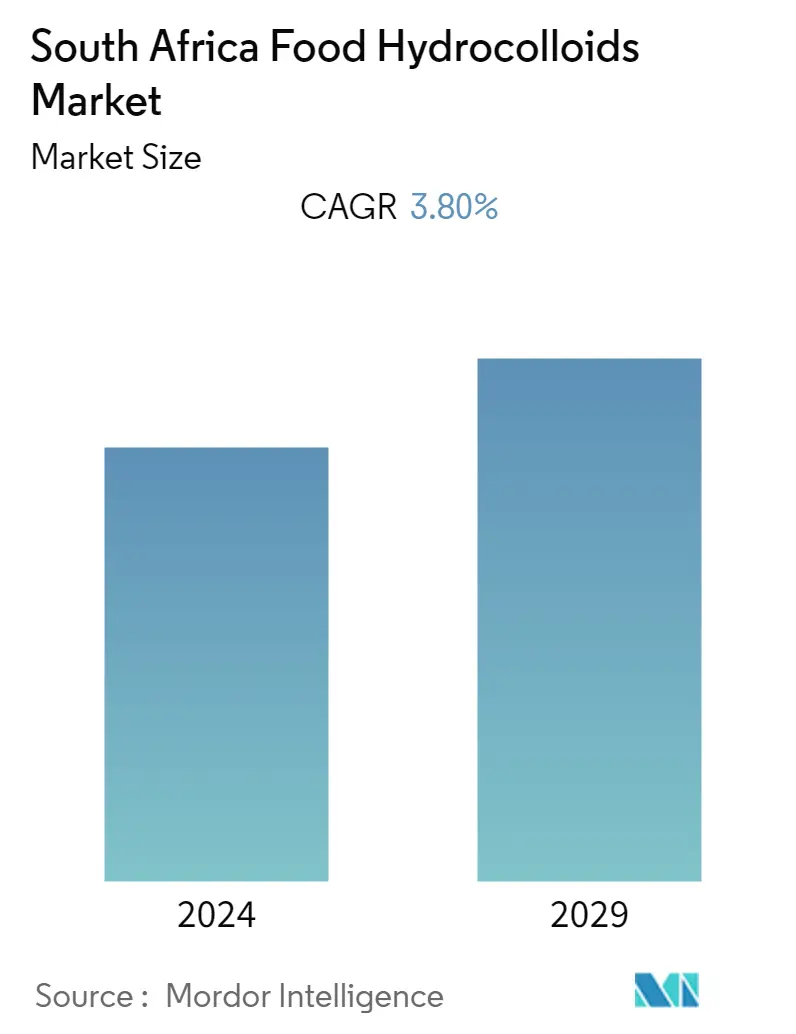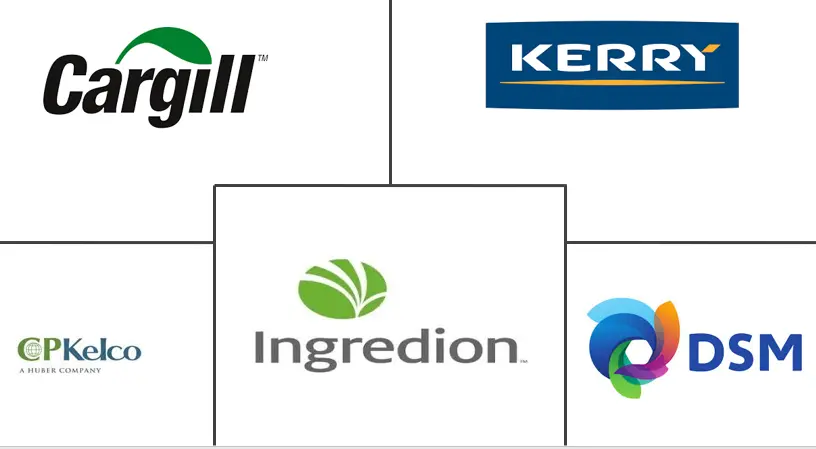Market Size of South Africa Food Hydrocolloids Industry

| Study Period | 2019 - 2029 |
| Base Year For Estimation | 2023 |
| Forecast Data Period | 2024 - 2029 |
| Historical Data Period | 2019 - 2022 |
| CAGR | 3.80 % |
| Market Concentration | Low |
Major Players
*Disclaimer: Major Players sorted in no particular order |
South Africa Food Hydrocolloids Market Analysis
The South African food hydrocolloids market is expected to grow at a CAGR of 3.8% during the forecast period (2020 - 2025).
The growing food industry, along with the overall food retail sector, has a major role to play in the growth of the thickeners segment for hydrocolloids. Apart from this, the changing consumer preference favoring the dense ready-to-eat products is another key factor driving the overall growth of the segment.
Product innovation in hydrocolloids is majorly focused in the bakery and confectionery segment of the country, owing to increasing per capita consumption. Although gelatin is widely used, consumers demanding for vegan and kosher labels are enabling the companies to look at naturally derived raw materials to meet their demand.
South Africa Food Hydrocolloids Industry Segmentation
The South African food hydrocolloids market is segmented by type and application. Based on type, the market has been further segmented into gelatin gum, pectin, xanthan gum, and other types. Whereas based on application, the market has been segmented into dairy and frozen products, bakery and confectionery, beverages, meat and seafood products, oils and fats, and other applications.
| By Type | |
| Gelatin Gum | |
| Pectin | |
| Xanthan Gum | |
| Other Types |
| By Application | |
| Dairy and Frozen Products | |
| Bakery and Confectionery | |
| Beverages | |
| Meat and Seafood Products | |
| Oils and Fats | |
| Other Applications |
South Africa Food Hydrocolloids Market Size Summary
The South African food hydrocolloids market is experiencing growth driven by the expanding food industry and evolving consumer preferences for dense ready-to-eat products. This growth is particularly evident in the thickeners segment, which benefits from product innovations in the bakery and confectionery sectors. The demand for vegan and kosher options is prompting companies to explore naturally derived raw materials, enhancing the appeal of hydrocolloids like xanthan, guar, and locust bean gums. These ingredients are crucial in achieving desired viscosities in various food applications, such as bread and cake mixes, and are also used in sauces and beverages for emulsification purposes. The increasing food retail sales in South Africa further bolster the market, with hydrocolloids also finding applications in pharmaceuticals, personal care, and industrial processes.
The market is characterized by intense competition, with major players like DuPont de Nemours Inc. and Cargill Incorporated holding significant market shares. These companies focus on developing innovative solutions to improve the taste, texture, and nutritional profiles of processed foods, thereby extending the shelf life of consumer products. The rising use of xanthan gum as a cost-effective alternative to guar gum across various food applications, including salad dressings and dairy products, is expected to drive market growth. The shift away from gelatin due to health concerns and cost factors has further increased the demand for xanthan gum in the confectionery segment, highlighting the dynamic nature of the market.
South Africa Food Hydrocolloids Market Size - Table of Contents
-
1. MARKET DYNAMICS
-
1.1 Market Drivers
-
1.2 Market Restraints
-
1.3 Industry Attractiveness - Porter's Five Forces Analysis
-
1.3.1 Threat of New Entrants
-
1.3.2 Bargaining Power of Buyers/Consumers
-
1.3.3 Bargaining Power of Suppliers
-
1.3.4 Threat of Substitute Products
-
1.3.5 Intensity of Competitive Rivalry
-
-
-
2. MARKET SEGMENTATION
-
2.1 By Type
-
2.1.1 Gelatin Gum
-
2.1.2 Pectin
-
2.1.3 Xanthan Gum
-
2.1.4 Other Types
-
-
2.2 By Application
-
2.2.1 Dairy and Frozen Products
-
2.2.2 Bakery and Confectionery
-
2.2.3 Beverages
-
2.2.4 Meat and Seafood Products
-
2.2.5 Oils and Fats
-
2.2.6 Other Applications
-
-
South Africa Food Hydrocolloids Market Size FAQs
What is the current South Africa Food Hydrocolloids Market size?
The South Africa Food Hydrocolloids Market is projected to register a CAGR of 3.80% during the forecast period (2024-2029)
Who are the key players in South Africa Food Hydrocolloids Market?
Tranarc Holdings (Pty) Ltd, Ingredion Incorporated, Palani Group, Cargill Incorporated, Kerry Group PLC, CP Kelco and Koninklijke DSM NV are the major companies operating in the South Africa Food Hydrocolloids Market.

